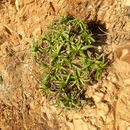en
names in breadcrumbs


Plantago maritima, the sea plantain, seaside plantain or goose tongue, is a species of flowering plant in the plantain family Plantaginaceae. It has a subcosmopolitan distribution in temperate and Arctic regions, native to most of Europe, northwest Africa, northern and central Asia, northern North America, and southern South America.[2][3]
It is a herbaceous perennial plant with a dense rosette of leaves without petioles. Each leaf is linear, 2–22 cm long and under 1 cm broad, thick and fleshy-textured, with an acute apex and a smooth or distantly toothed margin; there are three to five veins. The flowers are small, greenish-brown with brown stamens, produced in a dense spike 0.5–10 cm long on top of a stem 3–20 cm tall.[4][5][6]
There are four subspecies:[3][6]
In much of the range it is strictly coastal, growing on sandy soils. In some areas, it also occurs in alpine habitats, along mountain streams.[4] Some of the physiology and metabolism of this species has been described, of particular note is how the metabolism of this species is altered with elevated atmospheric carbon dioxide concentrations.[7][8]
Like samphires, the leaves of the plant are harvested to be eaten raw or cooked.[9][10] The seeds are also eaten raw or cooked, and can be ground into flour.[9]
Plantago maritima, the sea plantain, seaside plantain or goose tongue, is a species of flowering plant in the plantain family Plantaginaceae. It has a subcosmopolitan distribution in temperate and Arctic regions, native to most of Europe, northwest Africa, northern and central Asia, northern North America, and southern South America.